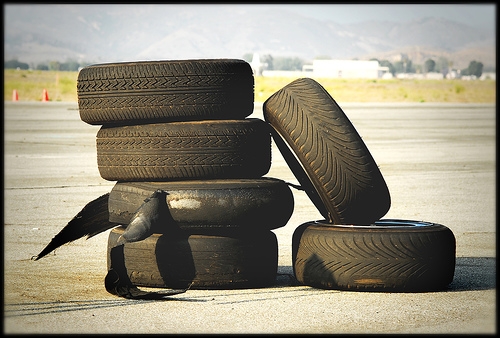
Toe wear is one type of wear pattern found on used tires and usually signifies either a misaligned or worn suspension. Though a certain amount of toe--in or out--is desirable to the tuning of handling characteristics, an excessive amount can lead to rapid tire wear, vehicle instability, poor handling and dangerous steering wheel play.
All suspensions have a certain amount of toe dialed in. This crucial setting defines the angle of the wheels relative to the longitudinal line of the chassis. If the tires are angled in toward each other, they are said to have a "toe-in" position; tires that point outward have "toe-out." Toe can be expressed in either degrees off of vehicle center-line or by the difference in distance between the fronts of the two tires and the rears.
A setting of zero-toe (wheel pointed straight ahead) gives the least amount of rolling resistance, best acceleration and top speed. The reason that vehicles have any toe at all is that this setting affects its straight-line stability and cornering agility. A slight toe-in (wheels pointed in) will make the vehicle more stable at speed, but will reduce steering response. Toe-out angle will make the car's steering response sharper, but make make it a bit darty.
Because toe in or out causes the tire to move ever so slightly sideways, any excessive amount will cause rapid and uneven wear on the tires. It is for this reason that toe must be tightly defined to maintain. Excess wear on the tie-rod ends, steering linkages or steering arms can increase toe angle. Worn rear control arm bushings can have the same effect, but this degree of wear is relatively rare.
Toe-related tire wear is easy to recognize, as it is fairly distinct compared with other types. Excessive toe-out will cause a feathered wear pattern on the inside of the tire tread; too much toe-in will wear on the outsides. Toe-related wear can be distinguished from camber-related wear as it is at a much smoother angle and may spread over half the tread of the tire. This contrasts with camber-wear, which is usually only in a narrow area near the shoulder of the tire and abruptly disappears.
Toe wear is almost always caused by excessive toe-out, which is the result of worn components. Worn bushings and components must be replaced, but bent components can often be hammered back into shape. However, the vehicle should have a thorough alignment after repairing bent components, since the alignment settings may not revert evenly.